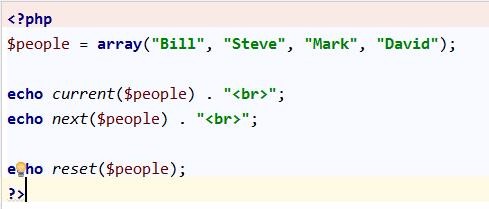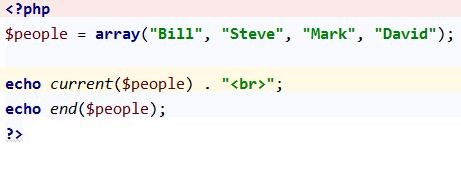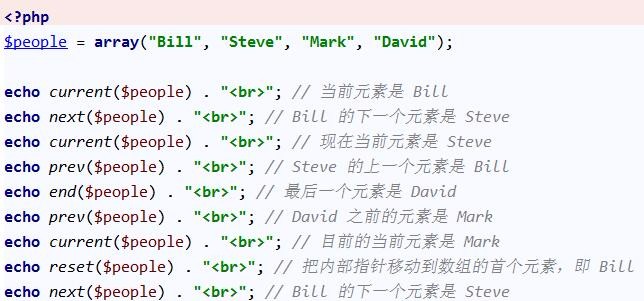10 recommended articles about current()
The current() function in php returns the current element (unit) in the array. Each array has an internal pointer pointing to its "current" unit, which initially points to the first unit inserted into the array. If we execute current once, the internal pointer will point to the next unit, and we can use current to get the value of the current unit in the array. This article collects several articles on the usage of PHP's array operation function current(). I hope it will be helpful to everyone's understanding of array operations. 1.php array function current() definition and usage The current() function in php returns the current element (unit) in the array. If the current element is empty or the current element has no value, it returns FALSE. Each array has an internal pointer pointing to its "current" element, which initially points to the first element inserted into the array. This function does not move the internal pointer of the array. If you need to move the pointer, you need to cooperate with other functions. Let’s take a look. 2. Detailed explanation of php end() function and current() function usage examples in php end
1. current() 10 recommended content

Introduction: The current() function in PHP returns the current element (unit) in the array. Each array has an internal pointer pointing to it. Its "current" unit initially points to the first unit inserted into the array. If we execute current once, the internal pointer will point to the next unit, and we can use current to get the value of the current unit in the array. This article collects several articles on the usage of PHP's array operation function current(). I hope it will be helpful to everyone's understanding of array operations. 1.php array function current(...
##2. Recommended 10 articles about current()

Introduction: The current() function in PHP returns the current element (unit) in the array. Each array has an internal pointer pointing to its "current "Unit, initially points to the first unit inserted into the array. If we execute current once, the internal pointer will point to the next unit. We can use current to get the value of the current unit in the array. This article collects several Regarding the usage of the PHP array operation function current(), I hope it will be helpful to everyone's understanding of array operations. 1. PHP array function current(...
3. Related pointers. Recommended 10 articles pointed to

##4.
Recommended 10 articles about php current ##Introduction: The current() function in PHP returns the current element (unit) in the array. Each array has an internal pointer pointing to its "current" unit, which initially points to the element inserted into the array. In the first unit, if we execute current once, the internal pointer will point to the next unit. We can use current to get the value of the current unit in the array. This article collects several articles on the usage of the PHP array function current(). , I hope it will be helpful for everyone to understand array operations. 1.php array function current(...
##Introduction: The current() function in PHP returns the current element (unit) in the array. Each array has an internal pointer pointing to its "current" unit, which initially points to the element inserted into the array. In the first unit, if we execute current once, the internal pointer will point to the next unit. We can use current to get the value of the current unit in the array. This article collects several articles on the usage of the PHP array function current(). , I hope it will be helpful for everyone to understand array operations. 1.php array function current(...
##5. Recommended 10 articles about array operations
Introduction: The current() function in PHP returns the current element (unit) in the array. Each array has an internal pointer pointing to its "current" unit, which initially points to the element inserted into the array. For the first unit, if we execute current once, the internal pointer will point to the next unit, and we can use current to get the value of the current unit in the array. This article collects several articles on the usage of PHP's array operation function current(). I hope it will be helpful to everyone's understanding of array operations. 1.php array function current(...
##6. 10 recommended articles about php current() function

##7 .
php returns the elements in the array current() function usage summary Introduction: PHP The current() function returns the current element (unit) in the array. Each array has an internal pointer pointing to its "current" unit, which initially points to the first unit inserted into the array. If we execute current once , the internal pointer will point to the next unit, and we can use current to get the value of the current unit in the array. This article collects several articles on the usage of the PHP array operation function current(), hoping to help everyone understand array operations. Help.
Introduction: PHP The current() function returns the current element (unit) in the array. Each array has an internal pointer pointing to its "current" unit, which initially points to the first unit inserted into the array. If we execute current once , the internal pointer will point to the next unit, and we can use current to get the value of the current unit in the array. This article collects several articles on the usage of the PHP array operation function current(), hoping to help everyone understand array operations. Help.
##8. Detailed explanation of usage examples of php operation array functions current, next and reset functions
 Introduction: The current() function in PHP returns the current element (unit, which is the first element of the array) in the array. The next() function points the internal pointer to the array. The next element and outputs the value of the element. The reset() function points the internal pointer to the first element in the array and outputs the value of the element. This article mainly introduces the usage of current, next and reset functions in PHP. , describes in detail the specific usage of the functions current, next and reset for array operations in PHP in the form of examples. It has certain reference value for in-depth understanding of the usage of arrays. I hope it will be helpful to everyone's understanding of arrays
Introduction: The current() function in PHP returns the current element (unit, which is the first element of the array) in the array. The next() function points the internal pointer to the array. The next element and outputs the value of the element. The reset() function points the internal pointer to the first element in the array and outputs the value of the element. This article mainly introduces the usage of current, next and reset functions in PHP. , describes in detail the specific usage of the functions current, next and reset for array operations in PHP in the form of examples. It has certain reference value for in-depth understanding of the usage of arrays. I hope it will be helpful to everyone's understanding of arrays
9. Detailed explanation of usage examples of php end() function and current() function
 Introduction: The end() function in php points the internal pointer of the array to the last element and returns the value of the element, while the current() function returns the current element (unit) in the array, which is the first element of the array. , one of these two functions returns the first element of the array, and the other returns the last element of the array. Let’s take a look at the usage of these two.
Introduction: The end() function in php points the internal pointer of the array to the last element and returns the value of the element, while the current() function returns the current element (unit) in the array, which is the first element of the array. , one of these two functions returns the first element of the array, and the other returns the last element of the array. Let’s take a look at the usage of these two.
10. Definition and usage of php array function current()
##Introduction: The current() function in php returns an array The current element (unit) in , if the current element is empty or the current element has no value, it returns FALSE. Each array has an internal pointer pointing to its "current" element, which initially points to the first element inserted into the array. This function does not move the internal pointer of the array. If you need to move the pointer, you need to cooperate with other functions. Let’s take a look. 
[Related Q&A recommendations]:
PHP SplFileObject’s fgets() and fgetcsv() cannot return the correct value after seek() OK.
node.js - What does the first parameter of the Call function of the V8 engine Function class mean?
python2.7 - Is there an equivalent expression of async for in python 2.7?
The above is the detailed content of 10 recommended articles about current(). For more information, please follow other related articles on the PHP Chinese website!

Hot AI Tools

Undresser.AI Undress
AI-powered app for creating realistic nude photos

AI Clothes Remover
Online AI tool for removing clothes from photos.

Undress AI Tool
Undress images for free

Clothoff.io
AI clothes remover

AI Hentai Generator
Generate AI Hentai for free.

Hot Article

Hot Tools

Notepad++7.3.1
Easy-to-use and free code editor

SublimeText3 Chinese version
Chinese version, very easy to use

Zend Studio 13.0.1
Powerful PHP integrated development environment

Dreamweaver CS6
Visual web development tools

SublimeText3 Mac version
God-level code editing software (SublimeText3)

Hot Topics
 CakePHP Project Configuration
Sep 10, 2024 pm 05:25 PM
CakePHP Project Configuration
Sep 10, 2024 pm 05:25 PM
In this chapter, we will understand the Environment Variables, General Configuration, Database Configuration and Email Configuration in CakePHP.
 PHP 8.4 Installation and Upgrade guide for Ubuntu and Debian
Dec 24, 2024 pm 04:42 PM
PHP 8.4 Installation and Upgrade guide for Ubuntu and Debian
Dec 24, 2024 pm 04:42 PM
PHP 8.4 brings several new features, security improvements, and performance improvements with healthy amounts of feature deprecations and removals. This guide explains how to install PHP 8.4 or upgrade to PHP 8.4 on Ubuntu, Debian, or their derivati
 CakePHP Date and Time
Sep 10, 2024 pm 05:27 PM
CakePHP Date and Time
Sep 10, 2024 pm 05:27 PM
To work with date and time in cakephp4, we are going to make use of the available FrozenTime class.
 CakePHP File upload
Sep 10, 2024 pm 05:27 PM
CakePHP File upload
Sep 10, 2024 pm 05:27 PM
To work on file upload we are going to use the form helper. Here, is an example for file upload.
 CakePHP Routing
Sep 10, 2024 pm 05:25 PM
CakePHP Routing
Sep 10, 2024 pm 05:25 PM
In this chapter, we are going to learn the following topics related to routing ?
 Discuss CakePHP
Sep 10, 2024 pm 05:28 PM
Discuss CakePHP
Sep 10, 2024 pm 05:28 PM
CakePHP is an open-source framework for PHP. It is intended to make developing, deploying and maintaining applications much easier. CakePHP is based on a MVC-like architecture that is both powerful and easy to grasp. Models, Views, and Controllers gu
 How To Set Up Visual Studio Code (VS Code) for PHP Development
Dec 20, 2024 am 11:31 AM
How To Set Up Visual Studio Code (VS Code) for PHP Development
Dec 20, 2024 am 11:31 AM
Visual Studio Code, also known as VS Code, is a free source code editor — or integrated development environment (IDE) — available for all major operating systems. With a large collection of extensions for many programming languages, VS Code can be c
 CakePHP Creating Validators
Sep 10, 2024 pm 05:26 PM
CakePHP Creating Validators
Sep 10, 2024 pm 05:26 PM
Validator can be created by adding the following two lines in the controller.






